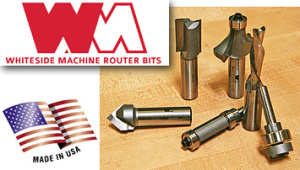Choosing the Correct Speed for your Router Bits

Selecting the best router bit for your application is key in getting quality results, but is not enough on it’s own. Once you have the correct tool for the job, you need to use the correct speed for optimum results. Most manufactures offer a chart or a general break down with the suggested RPM for the type of bit and sometimes for the material being used. But, what about the router bit you purchase online?
Perhaps you catch one of Carbide Processors’ sales on Whiteside Router Bits; you receive your American-made bit for your wood application and a nice note for choosing us, to serve you. You are excited and ready to use that router bit, until you start to use it. Then you are faced with what speed is needed to run it correctly for the best cut, cleanest finish and least amount of chip out.
If you are just starting out with woodworking, or maybe you don’t have a handy chart RPM nearby. There is an easy way to figure out the correct speed, or at least come really, really close, just by using your ears or by feel.
Any rotating system has speeds where transverse vibration is at a minimum (nodal point), and speeds where vibration is a lot more pronounced (resonance point), maybe more violent if you will. In some cases you can hear the difference, but in others you need to feel the difference when the bit is in use.
To improve surface finish, cut down on noise level, reduce bearing wear and improve the longevity of your router bits, it is recommended to always operate at the quiet nodal point.
When cutting wood and plastic, the less noise the better, especially when working with new material! Wood can be especially tricky because of the differences from batch-to-batch between cast and extruded products. However, in most cases the router bit you are using will let you know via high pitched squeals if you are trying to turn it too fast for the material being cut.
A nice cut and dried method for finding the best maximum speed is by doing the following:
- Load the tool and make sure the nut is properly tightened
- Set the speed to the highest nodal point
- Calculate the test feed by :
- multiplying the diameter of the bit by 0.02 to determine chip load
- multiply the chip load by the number of flutes on the cutter to get the total chip load
- multiply the total chip load by the speed (RPM) to calculate the test feed
**1/2 dia. 2 flute cutter with a speed (RPM) of 12,000 would be- 0.5 x 0.02 x 2 (flutes) x 12,000 = 120 inches per minute
*Feed rate refers to the speed that the router bit will move through the material and is measured in inches per minute.
*Speed rate refers to the speed that the router bit is moving and is measured in revolutions per minute (RPM).
*Chip load is the measurement of material in inches removed by the cutting edge during a cut.
Tags: American Made, carbide router bits, router bit, RPM, Whiteside router bits, woodworking
One Response to “Choosing the Correct Speed for your Router Bits”
Leave a Reply




Thanks for lot of information about router bits. I am getting so much help from your blog to choose best router bits. Your blog has been clearly explain each and every thing. https://www.holbren.com